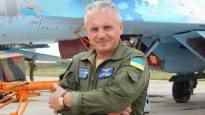Ukraine has been able to continue its resistance in the air, even though the superiority of the Russians is crushing on paper. The diligent performance of the Russian Air Force has amazed observers.
Ukraine’s best-known, or really the only well-known fighter pilot of this war is Oleksandr Oksanchenko. He was an Air Force show pilot who also performed abroad with the award-winning Suhoi Su-27 fighter.
Oksanchenko retired from the Air Force as a colonel in 2018. After the Russian invasion, he returned to service. On the first night of the war, on Friday, February 25, he was killed over Kiev.
According to the official version, Oksanchenko was dropped by Russia’s S-400 anti-aircraft missile. However, at that time they were only on the Belarusian side of the border.
It is not known on which plane the former colonel was in the air. He was said to have “deceived” the enemy air force. The crash was not announced until Tuesday, March 1st.
The case is likely to be seen in the next video, even though it talks about dropping a Russian plane.
Ukraine has reported almost every day on the counterparty’s losses, and on its own. For example, this week on Tuesday there was a report of an air fight in which two Russian Suhoi Su-35 fighters would have been dropped and one of their own MiG-29s lost. On Thursday, two Russian Suhoi fighters were said to have been shot down.
In all, Ukraine says it has dropped 30 planes and 31 helicopters by Friday. Most have been shot down with anti-aircraft missiles.
Nothing can be said about the veracity of the figures, but in the next video, a Russian helicopter gets hit and falls into the water near Kiev. Others fire flares to deflect missiles.
Russia says it has shot down 11 Ukrainian planes, seven helicopters and 46 drones.
Blows to bases
The attacks by the Ukrainian Air Force and the Drones on the attack lines of the Russian ground forces and the vehicles in them have received the most attention in public. However, Ukraine has also hit a Russian air base.
Last Friday, the second day of the war, Ukraine fired at least one Tochka-U missile at the Millerovo air base near the Ukrainian border on the Russian side. There is no certainty about the damage, but one Suhoi fighter seemed to be (you are switching to another service) on fire.
Russia, meanwhile, has bombed at least one Ukrainian air force airport – in Ivano-Frankivsk in western Ukraine on Sunday. The video shows several badly damaged Ukrainian MiG-29 fighters.
The damaged machines were possibly out of service because they were not protected in any way.
At the beginning of the war, Ukraine had about 70 Mikoyan MiG-29 fighters, of which about 40 were kept in flight condition. Correspondingly, more than 20 of the approximately 50 Suhoi Su-27 fighters were in flight condition. The rest remained unused and spare parts were taken from them.
Russian cautious air force
Russia launched the attack last Thursday with the launch of dozens of Iskander and Kalibr missiles at Ukrainian targets. The intention was to destroy, among other things, the radars of Ukraine’s air defense, and in Mariupol, for example, this seemed to be the case:
However, after the initial missile strikes, no fierce wave of airstrikes followed. Such was expected, as Russia had assembled about 300 fighter jets in the vicinity of Ukraine and in the Crimea.
The ground forces invading Ukraine were supported by helicopters, but Ukraine has dropped several of them with anti-aircraft missiles.
Russia said on Monday it had gained air control over Ukraine, but that was not true. The Ukrainian air force is still able to operate – to fight Russian helicopters and to destroy Russian military equipment from the air.
“The surprise of the air war has been that Russia has not used its air force with all its might,” says the lieutenant colonel, chief teacher of air warfare at the National Defense College. Inka Niskanen.
According to Bronk, the Russian Air Force may have a shortage of precision weapons, and many pilots have no experience in using them. At the beginning of the campaign, Russia said it was avoiding civilian casualties, and then targeted weapons are needed.
Towards the end of this week, information about free strikes on civilian targets has become more frequent. Here are the views of the city of Irpen from Thursday:
– Russia has not yet launched similar bombardments of civilian targets with its air force as in Syria, but is trying to destroy critical infrastructure, says Niskanen.
Critical infrastructure refers to structures that are important to the functioning and defense of society.
Poor air and ground coordination
Another reason, according to Bronk, may be the problems of communication and coordination between the Russian Air Force and the ground forces. The Air Force does not necessarily rely on the Air Force’s air defense units not firing their own planes.
Lieutenant Colonel Niskanen considers the lack of coordination between the ground and air forces to be the main reason for the caution of Russian air operations – although he admits that the Syrian expedition may have consumed Russian aircraft and precision weapons stockpiles.
– There are no signs that Russia will increase the pace of the air war in the near future, says Niskanen.
There is no possibility for that either in Ukraine, whose equipment is both smaller and of lower quality than in Russia.
During the first week of the Ukrainian Air War, there have been clashes between individual planes or pairs.
– There have been no large-scale fighter battles, says Lieutenant Colonel Niskanen.
